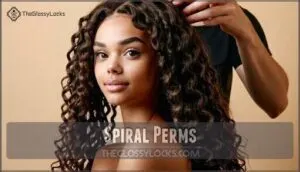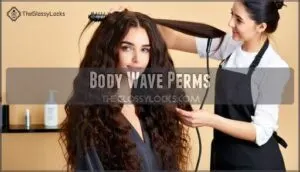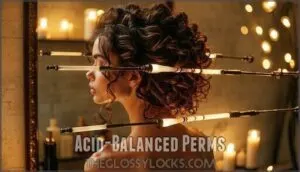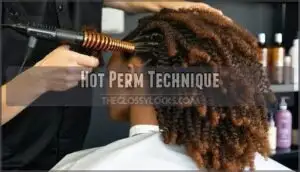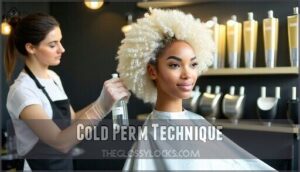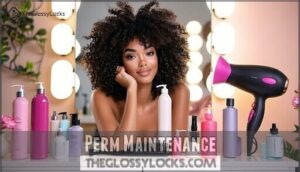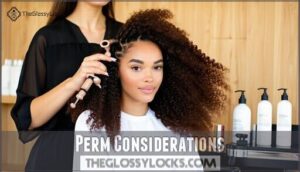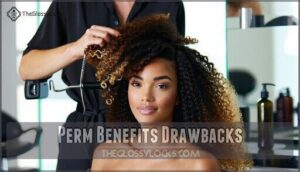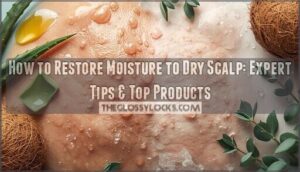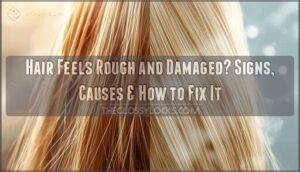This site is supported by our readers. We may earn a commission, at no cost to you, if you purchase through links.
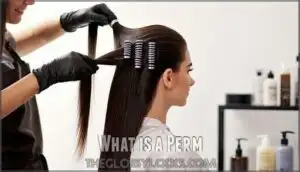
The process breaks down your hair’s natural bonds using chemicals, then reforms them around rods or rollers to lock in the new texture.
You’ll get curls that last 3-6 months without daily styling—perfect if you’re tired of spending hours with curling irons every morning.
Modern perms aren’t your grandmother’s frizzy disasters; today’s techniques offer everything from loose beach waves to tight spirals.
The key is choosing the right type for your hair texture and desired look, plus following proper aftercare to keep your new curls healthy and bouncy.
The result is a low-maintenance hairstyle that can significantly reduce your daily styling time, making it an attractive option for those with busy schedules, and the variety of techniques available ensures that you can achieve the look you want.
Table Of Contents
- Key Takeaways
- What is Perm
- What is a Perm
- Types of Perms
- Perm Techniques
- Perm Maintenance
- Perm Considerations
- Perm Benefits Drawbacks
- Frequently Asked Questions (FAQs)
- What does iperms stand for?
- How does the perm look after it’s done?
- Why do I have access to iperms?
- What does view as original mean in iperms?
- Is a perm just curly hair?
- How long does a perm last for?
- Will a perm damage your hair?
- What is a perm for a guy?
- What is a perm vs relaxer?
- Is getting a perm worth it?
- Conclusion
Key Takeaways
- You’ll get lasting curls or waves for 3-6 months without daily heat styling, making mornings faster and easier with low-maintenance hair that holds its shape naturally.
- Modern perms aren’t the frizzy disasters of the past – today’s techniques, like digital perms and acid-balanced treatments, offer everything from soft beach waves to defined spirals with less damage.
- You’ll need to adjust your hair care routine by waiting 48-72 hours before washing, using sulfate-free products, and deep conditioning weekly to keep your curls healthy and bouncy.
- Consider your hair type and condition carefully before getting a perm, as damaged or over-processed hair faces higher breakage risks, and you’ll want to space any coloring treatments 1-2 weeks apart.
What is Perm
A perm is a chemical hair treatment that permanently alters your hair’s natural structure to create curls or waves.
You’ll get lasting texture and volume that can transform straight hair into bouncy curls or add body to limp locks.
Definition of Perm
A perm breaks down your hair’s natural structure and rebuilds it into new patterns.
This chemical treatment transforms straight hair into lasting curls or waves through a multi-step perm process.
Here’s how it works:
- Hair Chemistry – Solutions alter protein bonds
- Curl Formation – Rods shape new patterns
- Neutralization – Sets the curl pattern permanently
- Hair Texture – Creates volume and movement
The process involves a series of steps that ultimately lead to the desired hair texture and pattern, with the perm process resulting in a lasting change to the hair’s natural structure.
History of Perm
Ancient civilizations pioneered hair evolution through crude curling methods, but modern perm origins trace to Karl Nessler’s revolutionary perm invention in 1905.
His permanent wave technique transformed vintage styles forever.
The 1980s elevated historical trends, making chemical treatments mainstream cultural symbols that redefined how you could achieve lasting curls.
| Era | Innovation | Impact |
|---|---|---|
| Ancient Times | Hot iron curling | Temporary styling foundation |
| 1905 | First permanent wave | Revolutionary chemical treatment |
| 1980s | Mass popularity | Curly perm became fashion statement |
Purpose of Perm
Understanding your hair’s potential comes down to recognizing what a permanent wave can accomplish.
This chemical treatment transforms your natural curl pattern and hair texture, giving you newfound style versatility. Whether you’re seeking curl enhancement or volume addition, a perm hairstyle delivers lasting hair revitalization.
Benefits of perming include understanding the chemical perm benefits that enhance overall appearance.
Benefits include:
- Enhanced curl definition for naturally straight hair seeking permanent wave transformation
- Dramatic volume addition for fine or limp hair lacking body
- Improved hair texture creating uniform curl patterns throughout your hair
- Long-lasting style versatility reducing daily styling time and effort
- Complete hair revitalization breathing new life into dull, lifeless strands
What is a Perm
Chemical transformation awaits your hair with a permanent wave, a salon treatment that restructures your strands at the molecular level.
You’ll experience Hair Chemistry in action as the chemical treatment breaks and reforms hair bonds, creating your desired curl pattern.
This process gives you freedom from daily styling routines while embracing new Hair Texture.
Perm History spans over a century, evolving from harsh chemicals to today’s gentler formulations.
Modern Perm Basics focus on customization rather than one-size-fits-all approaches.
Your perm hairstyle can range from subtle waves to dramatic spirals, depending on your vision.
| Perm Aspect | Description |
|---|---|
| Process Time | 2-4 hours at hair salon |
| Chemical Action | Breaks disulfide bonds in hair |
| Duration | 3-6 months typically |
| Curl Patterns | Loose waves to tight spirals |
The permanent wave process involves wrapping hair around rods, applying chemical solution, processing time, and neutralizing.
You’ll need patience during the transformation, but the results offer styling versatility.
Whether you’re seeking volume, texture, or dramatic Curl Patterns, perms provide lasting change that adapts to your lifestyle.
Understanding the best perm options is essential for achieving the desired hair transformation.
Types of Perms
You’ll discover six main perm types, each creating different curl patterns and textures to match your hair goals.
Understanding these options helps you choose the right perm for your hair type and desired look.
Spiral Perms
Tight, corkscrew-like curls transform your hair texture with spiral perm techniques that create dramatic volume and bounce.
This perm hairstyle uses smaller perm rods to achieve defined curl formation that lasts up to six months. You’ll love how spiral techniques work especially well on longer hair, though expect your length to reduce by several inches.
Here’s what makes spiral perms stand out:
- Instant volume boost – Your hair gains incredible fullness and body
- Long-lasting results – Enjoy beautiful curls for months without daily styling
- Versatile styling – Works perfectly with various hair textures and lengths
Proper curl maintenance involves using sulfate-free products and wide-tooth combs. Unlike a digital perm, spiral perms rely purely on chemical processing without heat, making them ideal for creating that bouncy, textured look you’re after.
Digital Perms
While spiral perms create tight corkscrews, digital perms offer you soft, natural waves through heat-regulated technology.
This perm solution works with heated perm rods to restructure your hair texture without the harsh chemicals of traditional methods.
You’ll see the most dramatic curl patterns when your hair’s dry, creating that effortless beachy look.
The perm results last 3-6 months and work especially well on straight or fine hair.
Your permanent wave appears more natural than other techniques, giving you freedom from daily styling while maintaining healthy-looking curls.
To maintain your digital perm, follow the proper aftercare tips for long-lasting results.
| Feature | Digital Perm | Traditional Perm | Spiral Perm |
|---|---|---|---|
| Curl Appearance | Soft, natural waves | Uniform tight curls | Tight corkscrews |
| Best When | Hair is dry | Hair is wet | Any moisture level |
| Duration | 3-6 months | 3-4 months | 4-6 months |
| Heat Used | Yes, controlled | No heat | No heat |
| Hair Damage | Minimal with care | Moderate | Higher risk |
Body Wave Perms
When you’re seeking loose waves that enhance your hair texture naturally, a body wave perm delivers exactly that.
This gentle technique uses larger perm rods and mild perm solutions to create subtle wave patterns without overwhelming your look.
Perfect for adding hair volume and curl enhancement to fine or limp hair, it transforms your natural texture into effortlessly beautiful waves that last months.
Beach Wave Perms
Beach wave perms create those coveted, effortless beachy waves that look like you’ve spent the day surfing.
This technique uses foam rollers and gentle perm solutions to transform straight hair into loose, organic wave patterns.
The result enhances your natural hair texture without the stiffness of traditional curls.
You’ll need specific curl enhancement products to maintain definition, but it’s surprisingly low-maintenance once styled properly.
Cold Wave Perms
While beach wave perms create soft waves, cold wave perms deliver tight, defined curl patterns using ammonium thioglycolate perm solution at room temperature.
This Cold Perm Process wraps your hair around perm rods without heat, making it gentler than a digital perm.
You’ll get bouncy curls that add incredible volume to fine hair texture.
The results last 2-3 months with proper Perm Aftercare, giving you that classic springy look that’s both dramatic and manageable.
For more information on permanent waves, consider researching hair perm types to find the best fit for your hair.
Acid-Balanced Perms
While cold wave perms work quickly without heat, acid-balanced perms take a gentler approach to curl formation.
This chemical treatment uses a lower pH perm solution that’s kinder to your hair’s natural structure.
You’ll need heat during processing, which takes longer than traditional methods, but the gentle processing creates beautifully defined curls with superior damage control.
The acid perm works especially well if you have fine or chemically-treated hair that needs extra care during transformation.
Highlights:
- Requires heat
- Gentle chemical composition
- Longer processing time
- Defined, soft curls
- Ideal for sensitive hair
Visual Appeal:
- Picture your hair wrapped in heated rods, the warm acid-balanced perm solution working slowly to reshape each strand into perfect, bouncy spirals that feel as soft as they look
Perm Techniques
Understanding different perm techniques helps you choose the right method for your hair type and desired results.
Each technique uses specific processes and tools to create lasting curls or waves that match your styling goals, which is crucial for achieving the desired results.
Hot Perm Technique
Hot perm technique transforms your hair using controlled heat application and specialized perm solutions. This method works exceptionally well for coarse hair texture, creating defined curls through precise temperature management.
During the process, your stylist wraps hair around heated rods while applying perm solution. The heat accelerates curl formation, breaking and reforming hair bonds more effectively than cold methods. Digital perm technology allows exact temperature control, preventing overheating.
You’ll spend more time in the salon compared to cold techniques, but the results justify the investment. Hot perms deliver natural-looking curls that move beautifully with your hair’s natural flow.
To achieve the best results, for optimal outcomes, use high-quality perm rod sets that are designed for hot perm techniques.
| Aspect | Hot Perm Benefits | Considerations |
|---|---|---|
| Hair Type | Perfect for coarse, resistant hair | May be too intense for fine hair |
| Curl Quality | Defined, long-lasting curls | Requires skilled technician |
| Processing Time | 2-4 hours total | Longer than cold methods |
| Cost | Higher investment | Worth it for durability |
| Damage Control | Controlled heat prevents overprocessing | Needs proper aftercare routine |
This perm technique requires careful damage control through proper conditioning and heat protection products afterward.
Cold Perm Technique
While hot perms rely on heat, the cold perm technique takes a gentler approach to curl formation.
You’ll find this perm solution works wonders for fine hair without risking heat damage.
The Cold Perm Process transforms your hair texture through these key steps:
- Application: Ammonium thioglycolate perm solution penetrates wrapped hair, breaking natural bonds
- Processing: Rods shape curls during the 15-20 minute development time
- Neutralizing: Final solution reforms bonds, securing your new curl formation permanently
This perm technique costs less than digital perm options while delivering beautiful results.
Perm aftercare remains simple since there’s no heat-related stress on your strands.
Multi-Textured Perm Technique
When you’re ready to break free from uniform curl patterns, multitextured perm technique delivers the natural variation you’re craving.
This perm technique uses different rod sizes strategically placed in alternating directions, creating diverse curl patterns that mimic authentic hair texture.
You’ll achieve bouncy, dimensional curls with varied tightness levels throughout your hair.
The stylist wraps sections around different perm rods, applying perm solutions while alternating vertical and angled placements.
This approach creates more natural-looking results than traditional perm types or even digital perm methods.
Your finished look features soft, lived-in curls with effortless movement and volume.
Mix rod sizes smartly
Natural appearance
Uniformity balance
Root Perm Technique
Root perm technique targets your first 2-4 inches for instant volume without full commitment.
This perm solution focuses on root lifting while leaving length natural.
- Root touchups refresh existing perms without damaging ends
- Perm volume creates lift that lasts 1-2 months typically
- Hair texture enhancement works on straight or wavy hair
- Curl enhancement blends seamlessly with natural patterns
- Root lifting eliminates flat, lifeless hair at the scalp
Perfect for quick transformations and maintaining your hair perm between full treatments.
Perm Maintenance
Once you’ve got your perm, proper maintenance becomes vital to keep those curls looking fresh and healthy.
You’ll need to adjust your hair care routine substantially to protect your investment and make certain your perm lasts as long as possible, which is crucial for keeping your curls healthy.
Post-Perm Hair Care
Proper postperm care begins the moment you leave the salon. Wait 48-72 hours before your first wash to let curls fully set.
Use sulfate-free shampoos and deep condition weekly for ideal hair hydration. Gentle handling with wide-tooth combs preserves curl preservation while moisturizing products combat dryness.
Choose specialized perm products for effective frizz control and lasting results. Using a sulfate free shampoo is essential for maintaining healthy and vibrant curls.
Avoiding Heat Styling
Your hair perm deserves protection from heat’s damaging effects.
Heat styling tools can weaken curl structure and cause frizz, so embrace gentler alternatives.
Air-drying preserves your curl pattern naturally, while diffusers on cool settings offer controlled volume without damage.
- Heat Protection products create barriers against environmental stressors
- Styling Alternatives like scrunching maintain curl definition without tools
- Hair Preservation through microfiber towels reduces friction and breakage
These damage prevention methods keep your hair healthy while maintaining beautiful curls.
Moisturizing and Conditioning
Maintaining hair hydration becomes your new priority after avoiding heat tools.
Sulfate free shampoos won’t strip natural oils, while deep conditioning treatments restore bounce weekly.
Moisture masks provide intensive hair nourishment, and leave-in conditioners offer daily frizz control.
Your sulfatefree shampoo preserves curl structure while hair moisturizing products maintain softness.
Hair conditioning treatments keep perms healthy and defined.
Consistent hair health routines prevent dryness and breakage.
Using a sulfate free shampoo is essential for maintaining healthy hair.
Protecting Perm From Damage
Shield your curls from hair damage with smart damage control strategies.
Use heat protection products and sulfate-free formulas for hair protection.
Sleep on silk pillowcases to prevent frizz prevention overnight.
Regular trims stop hair breakage before it spreads.
Gentle handling and protein treatments support curl preservation and overall hair health for lasting results.
Perm Considerations
Before getting a perm, you’ll need to examine several important factors that can make or break your results.
Your hair type, budget, timing with hair coloring, and current hair condition all play vital roles in determining whether a perm is right for you.
The decision to get a perm should be based on careful consideration of these factors to ensure the best possible results.
Hair Type Considerations
Before choosing your perm, consider your hair type and hair texture.
Fine Hair thrives with volumizing perms, while Coarse Texture needs stronger solutions.
Hair Porosity affects chemical absorption—low porosity resists processing, high porosity over-processes quickly.
Your natural Curl Patterns influence results, and damaged hair faces higher Damage Risk.
Consult professionals for personalized hair curls, hair waves, or hair straightening recommendations.
Cost and Duration
When considering perm prices, you’ll invest $60-$250 depending on your hair length and chosen salon.
Treatment time varies substantially based on technique complexity.
Cost factors affecting your investment:
- Hair length directly impacts perm price and duration variance
- Urban salons charge $100-$200+ while rural locations average $40-$100
- Specialty techniques like digital perms command premium pricing
- Processing requires 2-5 hours for complete transformation
- Hair perm longevity spans 3-6 months with proper hair perm maintenance
Understanding the perm duration factors is vital for maintaining your perm’s style and longevity.
Coloring and Perm
Hair coloring and permanent wave treatments require careful timing to protect your hair’s integrity.
You’ll want to avoid bleaching before getting a perm, as it compromises hair bonds and increases damage risk from perm solution.
For ideal color protection and perm safety, space these chemical reactions 1-2 weeks apart.
This prevents color fade while preserving your digital perm results.
To ensure the best outcome, consider the following key points:
permanent wave treatments and hair coloring should be timed carefully, with chemical reactions spaced appropriately to prevent damage, and using ammonia-free products can help.
Hair Damage and Perm
Chemical perms can trigger perm damage and hair breakage when they weaken protein bonds.
Previously bleached hair faces higher chemical damage risks, potentially creating brittle strands and split ends.
You’ll want protein treatments and deep conditioning for frizz control and recovery.
Space treatments properly—rushing into another perm amplifies hair perm damage.
Smart timing and hair damage prevention keep your curls healthy while minimizing long-term effects.
Perm Benefits Drawbacks
Like any beauty treatment, perms offer exciting benefits alongside potential risks you’ll want to weigh carefully.
Understanding both the advantages and drawbacks helps you make an informed decision about whether a perm fits your hair goals and lifestyle.
Adding Volume and Fullness
Volume Techniques transform limp locks into luxurious manes through strategic perm benefits.
A volumizing perm creates dramatic lift, while body wave perms deliver subtle fullness without overwhelming texture.
These perm for volume solutions target fine strands specifically, boosting hair volume from roots to tips.
Hair thickening occurs as curls multiply your strands’ visual density.
Curl enhancement adds bounce and movement that lasts months.
Root perms focus on scalp areas for targeted lift.
Fullness products complement your perm’s effects, maintaining that coveted thickness between salon visits while protecting your investment.
Time-Saving Styling
Busy mornings become manageable when you’ve got the right Hair Hacks up your sleeve. A perm transforms your Morning Routines by delivering instant texture that works with minimal effort.
Here’s how perms revolutionize your hair styling approach:
- Quick Fixes with air-drying – Your curls form naturally without heat tools or lengthy styling sessions
- Beauty Shortcuts through curl-defining cream – One product enhances your perm’s natural pattern effortlessly
- Style Tips using a diffuser – Gentle drying maintains curl definition while adding volume quickly
- Perm for low maintenance living – Hair texture enhancement means fewer products and less daily manipulation
Wake up, scrunch with your favorite product, and you’re ready to conquer the day.
Potential Damage and Breakage
Despite promising gorgeous curls, perms carry significant risks that you’ll want to understand before committing. Hair breakage becomes a real concern as chemicals weaken your strands’ structure, making them vulnerable to snapping during styling.
Perm damage occurs when harsh solutions disrupt protein bonds, leading to split ends and chronic dryness. Your hair health suffers as natural oils get stripped away, requiring intensive moisture treatments.
| Common Issues | Prevention Tips |
|---|---|
| Chemical burns on scalp | Choose experienced stylists |
| Increased hair frizz | Use sulfate-free products |
| Brittle, breaking strands | Deep condition weekly |
| Moisture loss | Apply leave-in treatments |
Proper frizz control starts with gentle handling and quality aftercare products designed for chemically-treated hair.
Long-Term Effects of Perm
While perm damage might seem reversible, repeated treatments create lasting changes that affect your hair’s future.
Multiple perms can permanently alter your curl pattern and cause significant hair thinning over time.
- Hair breakage increases with each perm cycle, weakening strand structure
- Scalp damage from chemicals can lead to irritation and follicle problems
- Perm regrowth becomes increasingly difficult as hair loses natural elasticity
- Hair perm longevity decreases with accumulated chemical exposure over years
- Hair perm risks compound, making future styling options more limited and dangerous
Frequently Asked Questions (FAQs)
What does iperms stand for?
iPerms doesn’t stand for anything specific in hair terminology. You might be thinking of "perms," which are permanent wave treatments that chemically curl or straighten your hair using specialized solutions.
How does the perm look after it’s done?
Your fresh perm will showcase defined curls or waves, depending on the style you chose.
Spiral perms create bouncy, corkscrew curls, while body waves give you soft, flowing movement that enhances your hair’s natural texture beautifully, with soft movement.
Why do I have access to iperms?
You’ll have access to iPerms because it’s a modern perming technique that uses controlled heating technology for more precise, customizable curls compared to traditional chemical-only methods.
What does view as original mean in iperms?
Looking through military records can feel like discovering a treasure chest of your career history.
In iPERMS, "view as original" displays documents in their authentic format – exactly as they were scanned or uploaded, preserving all original formatting, signatures, and visual elements for official record-keeping purposes.
Is a perm just curly hair?
A perm isn’t just curly hair—it’s a chemical treatment that permanently reshapes your hair’s structure.
You can get loose waves, tight spirals, or even straightened hair depending on the technique used.
How long does a perm last for?
Time flies when you’re rocking curls.
Your perm’s lifespan depends on the type you choose.
Spiral and body wave perms typically last three to six months, while digital perms can maintain their bounce for up to a year with proper care, which is a key factor in making your perm last.
Will a perm damage your hair?
Chemical processing can weaken your hair’s structure, causing dryness and breakage if you’ve got damaged or over-processed hair. However, modern techniques like American Wave and Olaplex perms are gentler options.
What is a perm for a guy?
A guy’s perm adds texture and volume to your hair using chemical solutions and rods.
You’ll get anything from tight curls to loose waves, depending on your style goals and hair type.
What is a perm vs relaxer?
Nearly 40% of hair damage cases stem from chemical processing confusion.
A perm adds curls using chemicals that reshape your hair’s structure, while a relaxer straightens curly hair by breaking down bonds permanently.
Is getting a perm worth it?
Getting a perm can be worth it if you want lasting texture, volume, or waves without daily styling. Consider your hair’s condition, maintenance commitment, and desired look first.
Conclusion
Surprisingly, over 60% of salon clients who try their first perm become repeat customers within two years.
Now you understand what’s a perm and how it transforms your hair through chemical restructuring. Whether you’re considering spiral curls, beach waves, or adding volume, perms offer months of effortless styling.
Remember to choose the right technique for your hair type, follow proper aftercare, and work with an experienced stylist. With modern perm methods, you can achieve beautiful, lasting curls without the damage concerns of older techniques.
- https://www.webmd.com/beauty/what-to-know-hair-perms
- https://www.vogue.com/article/hair-perms
- https://www.verbproducts.com/blogs/verb-word/ultimate-guide-to-different-types-of-perms
- https://www.styleseat.com/blog/types-of-perms/
- https://www.bingo-cosmetic.com/blog/the-history-of-hair-perming-lotion-from-past-to-present/

